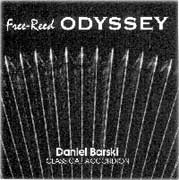 Reviewing Daniel Barski's recording would be every reviewers dream - I was
pleasantly surprised to find in the package with his recording, a copy of
the printed music to help facilitate my review, complete with thorough information
about the performer in English. So often, I am sent recordings and the CD
cover doesn't even provide any information about the performer. Often, if
there is information, it is not in English. Once a company released a CD
without saying who the performer was! In that regard Daniel's "recording
package" is superb and well organized.
Reviewing Daniel Barski's recording would be every reviewers dream - I was
pleasantly surprised to find in the package with his recording, a copy of
the printed music to help facilitate my review, complete with thorough information
about the performer in English. So often, I am sent recordings and the CD
cover doesn't even provide any information about the performer. Often, if
there is information, it is not in English. Once a company released a CD
without saying who the performer was! In that regard Daniel's "recording
package" is superb and well organized.Daniel began studying the accordion at the age of nine, mainly using the Sedlon method and focusing primarily on standards and Polish folk music. Lessons were discontinued at the age of 16 when Daniel joined the Navy. Daniel made no attempt to play until 1995 at the age of 47. "I rediscovered the magic of the accordion, and have since embraced it with a passion; however, due to the unavailability of formal instruction (I live in a rural area) I have pursued improvement through self-study, largely in isolation..." I find this remarkable and inspiring that Daniel basically self-taught achieved such a standard of performance. Before I describe what's on the recording I would like to explain the quite unusual way it was recorded. Daniel's message "To The Listener" from the cover of the CD would speak for itself the best. This is part of it: "The music on this album was recorded in my home studio with a multi-track recorder, a single musician (myself) and a single acoustic accordion. For most of the selections, one part of the piece was recorded to a track; then, while playing back that track, another part was recorded on a "parallel" track. The process was repeated for as many parts as required to complete the piece. In this way, I was able to record music that would normally not be possible for a soloist to perform. Although nearly all contemporary recordings utilize a multi-track process it is usually in the form of various musicians recording their parts to separate tracks, which are then "mixed". Recordings containing orchestral works performed solely by one artist using a single instrument are few. This, of course, is not due to a lack of musicianship on the part of other artists, but rather the nature of their instruments. What makes this recording possible is the wonderful versatility of the accordion....." This recording does sound like an accordion ensemble is playing and it creates quite an impressive sound picture.The only reservation I'd have would be towards the ability to use rubato in performance. It seems to me that such a way of recording restricts the use of rubato's needed especially in track 11 - "Melody" by Gluck. The sound quality of the recording itself is superb, the balance was just right and the amount of reverb perfect. Engineering wise it is quite a masterpiece. Daniel's performing style has a special touch to it. He creates an atmosphere and there is just something out of the ordinary to it. **** |